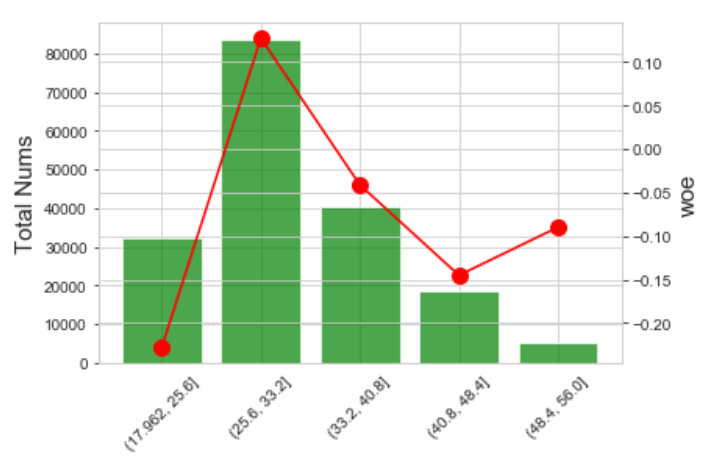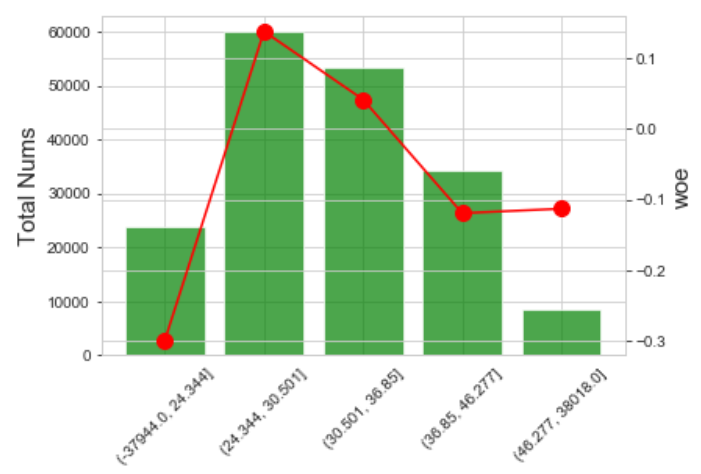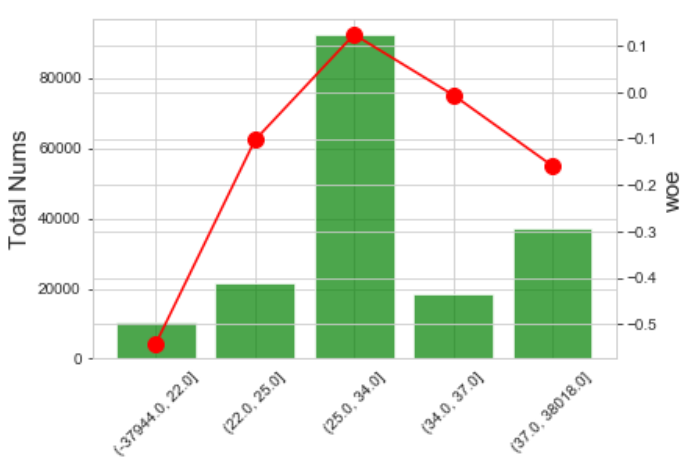【风控算法】一、变量分箱、WOE和IV值计算
一、变量分箱
变量分箱常见于逻辑回归评分卡的制作中,在入模前,需要对原始变量值通过分箱映射成woe值。举例来说,如“年龄”这一变量,我们需要找到合适的切分点,将连续的年龄打散到不同的”箱“中,并按年龄落入的“箱”对变量进行编码。
关于变量分箱的作用,相关资料中的解释有很多,我认为变量分箱最主要有三个作用:
- 归一化:分箱且woe编码映射后的变量,可以将变量归一到近似尺度上;
- 引入非线性:对于逻辑回归这类线性模型,引入变量分箱可以增强模型的拟合能力;
- 增强鲁棒性:分箱可以避免异常数据对模型的影响
二、IV值和WOE
(1)WOE
WOE(Weight of Evidence),是一种对变量编码的形式。通过对分箱后每一箱WOE值的计算,可以完成变量从原始数值->WOE数值的映射。
关于WOE的理解,主要有如下几点:
- WOE可以理解成分箱区间内的正负样本差异相对于整体的差异。机器学习二分类中,通常将分类任务中更关注的类label设为”1“,因此WOE越大说明该分箱内的样本越可能为“1”类;
- 经过WOE编码,实现了按WOE排序的区间正样本比例呈单调趋势。
(2)IV值
IV(Information Value)是基于WOE计算来的:
(3)KL散度
KL散度(相对熵)通常用于衡量两个分布之间的差异,机器学习中,\(P\)往往代表样本的真实分布,而\(Q\)代表样本的预测分布,那么KL散度可以计算两个分布之间的差异:
如果\(P\)的分布和\(Q\)的分布越接近,KL散度的值就会越小。
KL散度通常被称作KL距离,但却只满足距离的非负性和同一性,不满足对称性和直递性,因此不是严格意义上的“距离"。
设分箱后,\(y=1\)的分布为\(p_1(x)\),\(y=0\)的分布为\(p_0(x)\),那么
由此可知,\(IV=KL(p_0,p_1)+KL(p_1,p_0)\)
据此可以得到关于IV和KL散度更加深刻的理解:
- IV值衡量了分组下好坏样本分布差异,IV值越大分布差异越大,IV值越小分布差异越小
- IV是KL散度的一种对称化处理
三、分箱方法
变量分箱主要包括无监督方法和有监督方法,无监督的方法,在分箱中没有用到y有关的信息,而有监督的分箱方法,在分箱时引入了y的分布,运用训练集找到分箱的切点。
(1)无监督分箱
a.等频分箱/等距分箱
如字面理解,等频分箱和等距分箱可直接通过pandas的qcut和cut实现
等频分箱:qcut IV=0.0158

等距分箱:cut IV=0.019

b.聚类分箱
无监督分箱中除了等频分箱和等距分箱外,也可以使用KMeans算法实现聚类分箱,一个粗糙的代码实现如下:
from sklearn.cluster import KMeans
def kmeansbin(data,x='x',bin_nums=5):
minus_ = 999*(data[x].max() - data[x].min())
bin_nums = 5
clf = KMeans(n_clusters=bin_nums-1, random_state=999)
_ = clf.fit_predict(data[[x,x]])
cut_point = sorted(clf.cluster_centers_[:,0])
#cut_point = [(clf_center[i]+clf_center[i+1])/2 for i in range(len(clf_center)-1)]
return [data[x].min()-minus_,] + cut_point + [data[x].max()+minus_,]
效果如下: IV=0.0208

(2)有监督分箱
a.决策树分箱
决策树分箱利用单变量生成决策树,利用决策树的分裂规则完成变量分箱,因分箱速度快且效果比较稳定,同时也有sklearn接口可以调用,因此较为常用,一个简单的代码实现版本如下:
# 决策树分箱
from sklearn.tree import DecisionTreeClassifier
def treebin(df,x='x',y='y',max_leaf_nodes=5,min_samples_leaf=0.05):
# 训练决策树
df = df.copy()
df[x] = df[x].fillna(-9999)
model = DecisionTreeClassifier(criterion='entropy',max_leaf_nodes=max_leaf_nodes,min_samples_leaf=min_samples_leaf)
model.fit(df[[x]],df[[y]])
# 从树结构获取决策边界
right_node = model.tree_.children_right
left_node = model.tree_.children_left
tree_threshold = model.tree_.threshold
# sklearn树结构,详见:https://scikit-learn.org/stable/auto_examples/tree/plot_unveil_tree_structure.html#sphx-glr-auto-examples-tree-plot-unveil-tree-structure-py
final_cut = [tree_threshold[i] for i,node in enumerate(zip(right_node,left_node)) if node[0]!=node[1]]
minus_ = df[x].max() - df[x].min()
# 返回分箱边界
return [df[x].min()-999*minus_,]+sorted(final_cut)+[df[x].max()+999*minus_]
分箱效果如下: IV=0.0286

b.卡方分箱
卡方分箱通过计算变量所有不同值之间的卡方值,并对卡方值最低的区间进行合并迭代,最终达到迭代要求的剩余箱数来完成分箱,简要代码实现如下:
def chibin(data,x='x',y='y',bin_nums=5,confidenceVal=6.635):
def cal_chi(arr):
sum_ = np.sum(arr[:,:2])
denom_ = np.sum(arr[0,:2])*np.sum(arr[1,:2])*np.sum(arr[:,0])*np.sum(arr[:,1])
chi_ = (arr[0][0]*arr[1][1] - arr[0][1]*arr[1][0])**2 * sum_ / denom_
return chi_
# 所有不同值,计数
total_num = data.groupby([x])[y].apply(lambda x:{'nums':x.count()}).unstack()
# 正样本计数
total_num['x'] = total_num.index.tolist()
total_num['pos_nums'] = data.groupby([x])[y].sum()
total_num['neg_nums'] = data.groupby([x])[y].apply(lambda x:x.count()-x.sum())
total_num = total_num[['pos_nums','neg_nums','x']]
total_num = total_num.values
# 第一步:合并连续的全正/全负区间
i = 0
while i<len(total_num)-1:
if (total_num[i][0] == total_num[i+1][0] == 0) or (total_num[i][1] == total_num[i+1][1] == 0):
total_num[i,2] = 0
total_num[i] += total_num[i+1]
total_num = np.delete(total_num,i+1,axis=0)
else:
i += 1
# 第二步:计算相邻区间的卡方值,并存入数组
arr_chi = np.array([])
for i in range(len(total_num)-1):
arr_chi = np.append(arr_chi,cal_chi(total_num[i:i+2]))
# 第三部:分箱合并
while len(arr_chi)>bin_nums and min(arr_chi)<confidenceVal:
idxmin = np.argmin(arr_chi)
# 与下一个区间合并
total_num[idxmin,2] = 0
total_num[idxmin] += total_num[idxmin+1]
total_num = np.delete(total_num,idxmin+1,axis=0)
# 更新卡方值
# 如果 最低卡方值是前两个区间
# 如果 最低卡方值是最后两个区间
# 如果 最低卡方值在中间
if idxmin == 0:
arr_chi[0] = cal_chi(total_num[:2])
arr_chi = np.delete(arr_chi,1,axis=0)
elif idxmin == len(arr_chi)-1:
arr_chi[idxmin-1] = cal_chi(total_num[idxmin-1:])
arr_chi = np.delete(arr_chi,idxmin,axis=0)
else:
arr_chi[idxmin-1] = cal_chi(total_num[idxmin-1:idxmin+1,:])
arr_chi[idxmin+1] = cal_chi(total_num[idxmin:idxmin+2,:])
arr_chi = np.delete(arr_chi,idxmin,axis=0)
# 合并完毕,返回分箱边界
minus_ = total_num[:,2].max() - total_num[:,2].min()
return [total_num[:2].min() - 999*minus_,] + sorted(total_num[:-1,2]) + [total_num[:2].max() + 999*minus_,]
卡方值和KL散度一样,都是用于衡量分布之间差异的指标,因此处不是重点,所以不再详细说明
效果如下: IV=0.0303

c.BestKS分箱
BestKS分箱通过不断计算所有可能切分点的KS,每次分箱选择让KS最大的切分点,最终达到要求的分箱数来完成分箱,具体的实现思路其他文章中都有较为详细的介绍,因此此处也不再赘述。
一个简要的代码实现:
def bestksbin(data,x='x',y='y',bin_nums=5,stopl=0.05):
cut_point = []
minus_ = 999*(data[x].max() - data[x].min())
if len(data[x].unique())<=bin_nums:
cut_point = data[x].unique()
return [data[x].min()-minus_,] + cut_point + [data[x].max()+minus_,]
cut_point.append(binks(data,x,y)[0])
while len(cut_point) < bin_nums-1:
bestks = -999
bestcut = None
icnt = 0
while icnt <= len(cut_point):
if icnt == 0:
tmpcp,tmpks = binks(data[data[x]<=cut_point[icnt]],x,y,l=data.shape[0],stopl=stopl)
elif icnt == len(cut_point):
tmpcp,tmpks = binks(data[data[x]>cut_point[icnt-1]],x,y,l=data.shape[0],stopl=stopl)
else:
tmpcp,tmpks = binks(data[(data[x]>cut_point[icnt-1])&(data[x]<=cut_point[icnt])],x,y,l=data.shape[0],stopl=stopl)
if tmpks > bestks:
bestcut,bestks = tmpcp,tmpks
icnt += 1
if not bestcut:
break
cut_point.append(bestcut)
cut_point = sorted(cut_point)
return [data[x].min()-minus_,] + cut_point + [data[x].max()+minus_,]
def binks(data,x='x',y='y',l=10000,stopl=0.05):
if (len(data[x].unique()) == 1) or (data.shape[0]/l<stopl) or (data[y].sum()==data.shape[0]) or (data[y].sum()==0):
return None,-9999
tmp = data.groupby(x)[y].apply(lambda x:{'count':x.count(),'bad':x.sum()}).unstack()
tmp['x'] = tmp.index.tolist()
tmp['good'] = tmp['count'] - tmp['bad']
tmp['cumgood'] = tmp['good'].cumsum()
tmp['cumbad'] = tmp['bad'].cumsum()
tmp['cumgood_ratio'] = tmp['cumgood'] / (data.shape[0] - data['y'].sum())
tmp['cumbad_ratio'] = tmp['cumbad'] / data['y'].sum()
tmp['KS'] = abs(tmp['cumgood_ratio']-tmp['cumbad_ratio'])
tmp = tmp.reset_index(drop=True)
tmp = tmp[tmp['x'] != tmp['x'].max()]
maxidx = tmp['KS'].argmax()
return tmp.loc[maxidx ,'x'],tmp.loc[maxidx,'KS']
分箱效果如下: IV=0.0281

总结
本文主要记录了变量分箱、WOE和IV值计算,其中包括了有监督分箱的几种方法的代码实现,代码写的仓促可能其中有一些疏漏,在未来的学习和研究中可能会优化其中代码。
参考资料


